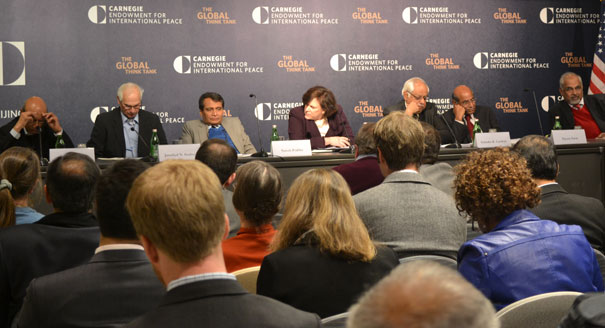Registration
You will receive an email confirming your registration.
The U.S.-India relationship has been in the news recently for all the wrong reasons. A slowing Indian economy, policy paralysis in the Indian government, and U.S. domestic distractions have combined to produce a drift in the bilateral relationship that is far more dangerous than the discord provoked by the diplomatic spat.
A group of leading Indian public figures discussed these issues and provide their perspectives on relations between the two countries. The speakers included Satinder K. Lambah, Tarun Das, Jamshyd Godrej, T N Ninan, Suresh Prabhu, and Shyam Saran. Carnegie’s Jessica T. Mathews moderated the discussion.
Tarun Das
Tarun Das has dedicated his professional career to the development and promotion of Indian industry. Starting in November 1963 with the predecessor body of Confederation of Indian Industry (CII) he was the director general and chief executive of CII from 1967 to 2004 and chief mentor from 2004 to 2009.
Jamshyd N. Godrej
Jamshyd N. Godrej is the chairman of the board of Godrej & Boyce Manufacturing Company Limited. Godrej is the chairman emeritus of Aspen Institute India (now known as Ananta Aspen Centre) as well as chairman and trustee of Ananta Centre.
Satinder K Lambah
Satinder K Lambah joined the Indian Foreign Service in 1964. Over a diplomatic career spanning more than four decades, he has served in several Indian missions across the globe. After retirement from the India Foreign Service in August 2001, he chaired a Committee on the Reorganization of the Ministry of External Affairs and India’s Missions Abroad. Since 2005, he has been special envoy in the Office of the Prime Minister of India.
T N Ninan
T N Ninan is the chairman of Business Standard Limited. He has been the editor of different newspapers and magazines over a quarter-century, leading radical change and achieving rapid growth in all of them under his stewardship. From 1986, he has been successively the executive editor of India Today, editor of the Economic TimesBusiness World, and most recently editor of Business Standard, where he has been chairman since 2009.
Suresh Prabhu
Suresh Prabhu is the former Indian federal cabinet minister of industry, energy, environment and forests, chemicals and fertilizers, heavy industry, and public enterprises. His key areas of expertise include finance, accounting, auditing, management consultancy, international negotiations, banking, cooperative practices, education, and policy framing. Prabhu was a member of parliament in the 11th, 12th, 13th, and 14th Lok Sabha (1996–2009).
Shyam Saran
Shyam Saran is a career diplomat. Since joining the Indian Foreign Service in 1970, he has served in postings including Beijing, Tokyo, and Geneva. After a career spanning 34 years in the Indian Foreign Service, Saran was appointed India’s foreign secretary in 2004 and held that position until his retirement in September 2006. Following his retirement, he was appointed prime minister’s special envoy for Indo-US civil nuclear issues and he was more recently appointed special envoy and chief negotiator on climate change.
Jessica T. Mathews
Jessica T. Mathews is president of the Carnegie Endowment. Before her appointment in 1997, her career included posts in both the executive and legislative branches of government, in management and research in the nonprofit arena, and in journalism and science policy.
The event was co-sponsored by the Ananta Aspen Centre. The Carnegie Endowment for International Peace is grateful for the support of the Indian Council for Cultural Relations in making this event possible.
